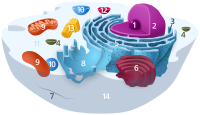
Photo from wikipedia
ETHNOPHARMACOLOGICAL RELEVANCE Ambroxol elevates glucocerebrosidase (GCase) activity and reduces nigrostriatal alpha-synuclein burden to better ameliorate motor function in Parkinson's disease (PD). Polygala tenuifolia is a potential alternative botanical medicine for… Click to show full abstract
ETHNOPHARMACOLOGICAL RELEVANCE Ambroxol elevates glucocerebrosidase (GCase) activity and reduces nigrostriatal alpha-synuclein burden to better ameliorate motor function in Parkinson's disease (PD). Polygala tenuifolia is a potential alternative botanical medicine for the treatment of many nonmotor symptoms of PD commonly used in Taiwanese patients. Co-administration of these two medicines pose potential herb-drug interaction. AIM OF THE STUDY Our hypothesis is that ambroxol and P. tenuifolia may potentially possess herbal drug synergetic effects in the blood and brain. MATERIALS AND METHODS To investigate this hypothesis, a multiple microdialysis system coupled with validated ultra-high performance liquid chromatography-tandem mass spectrometry (UPLC-MS/MS) method was developed for rat blood and brain samples. Experimental rats were divided into three groups: low-dose and high-dose ambroxol alone (10 mg/kg, i.v. and 30 mg/kg, i.v., respectively) and ambroxol (10 mg/kg, i.v.) pretreated with P. tenuifolia extract (1 g/kg, p.o. for 5 consecutive days). RESULTS Ambroxol easily penetrated into the brain and reached a maximum concentration in the striatum at approximately 60 min after low- and high-dose treatment. The area under the concentration curve (AUC) ratio increased proportionally at the doses of 10 and 30 mg/kg, which suggested a linear pharmacokinetic manner of ambroxol. The brain penetration of ambroxol was approximately 30-34%, which was defined as the ambroxol AUC blood-to-brain distribution ratio (AUCbrain/AUCblood). The P. tenuifolia extract did not significantly alter the pharmacokinetics of ambroxol in the blood and brain of rats. CONCLUSION The present study suggests that it is safety without pharmacokinetic interactions for this dosing regimen to use P. tenuifolia extract and ambroxol together.
Journal Title: Journal of ethnopharmacology
Year Published: 2020
Link to full text (if available)
Share on Social Media: Sign Up to like & get
recommendations!